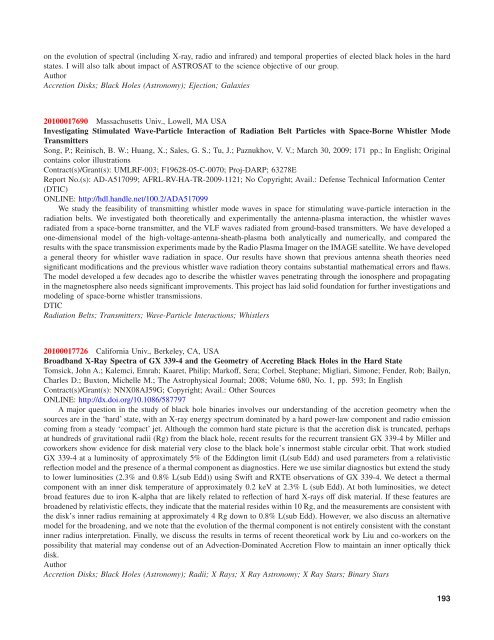NASA Scientific and Technical Aerospace Reports - The University ...
NASA Scientific and Technical Aerospace Reports - The University ...
NASA Scientific and Technical Aerospace Reports - The University ...
Create successful ePaper yourself
Turn your PDF publications into a flip-book with our unique Google optimized e-Paper software.
on the evolution of spectral (including X-ray, radio <strong>and</strong> infrared) <strong>and</strong> temporal properties of elected black holes in the hard<br />
states. I will also talk about impact of ASTROSAT to the science objective of our group.<br />
Author<br />
Accretion Disks; Black Holes (Astronomy); Ejection; Galaxies<br />
20100017690 Massachusetts Univ., Lowell, MA USA<br />
Investigating Stimulated Wave-Particle Interaction of Radiation Belt Particles with Space-Borne Whistler Mode<br />
Transmitters<br />
Song, P.; Reinisch, B. W.; Huang, X.; Sales, G. S.; Tu, J.; Paznukhov, V. V.; March 30, 2009; 171 pp.; In English; Original<br />
contains color illustrations<br />
Contract(s)/Grant(s): UMLRF-003; F19628-05-C-0070; Proj-DARP; 63278E<br />
Report No.(s): AD-A517099; AFRL-RV-HA-TR-2009-1121; No Copyright; Avail.: Defense <strong>Technical</strong> Information Center<br />
(DTIC)<br />
ONLINE: http://hdl.h<strong>and</strong>le.net/100.2/ADA517099<br />
We study the feasibility of transmitting whistler mode waves in space for stimulating wave-particle interaction in the<br />
radiation belts. We investigated both theoretically <strong>and</strong> experimentally the antenna-plasma interaction, the whistler waves<br />
radiated from a space-borne transmitter, <strong>and</strong> the VLF waves radiated from ground-based transmitters. We have developed a<br />
one-dimensional model of the high-voltage-antenna-sheath-plasma both analytically <strong>and</strong> numerically, <strong>and</strong> compared the<br />
results with the space transmission experiments made by the Radio Plasma Imager on the IMAGE satellite. We have developed<br />
a general theory for whistler wave radiation in space. Our results have shown that previous antenna sheath theories need<br />
significant modifications <strong>and</strong> the previous whistler wave radiation theory contains substantial mathematical errors <strong>and</strong> flaws.<br />
<strong>The</strong> model developed a few decades ago to describe the whistler waves penetrating through the ionosphere <strong>and</strong> propagating<br />
in the magnetosphere also needs significant improvements. This project has laid solid foundation for further investigations <strong>and</strong><br />
modeling of space-borne whistler transmissions.<br />
DTIC<br />
Radiation Belts; Transmitters; Wave-Particle Interactions; Whistlers<br />
20100017726 California Univ., Berkeley, CA, USA<br />
Broadb<strong>and</strong> X-Ray Spectra of GX 339-4 <strong>and</strong> the Geometry of Accreting Black Holes in the Hard State<br />
Tomsick, John A.; Kalemci, Emrah; Kaaret, Philip; Markoff, Sera; Corbel, Stephane; Migliari, Simone; Fender, Rob; Bailyn,<br />
Charles D.; Buxton, Michelle M.; <strong>The</strong> Astrophysical Journal; 2008; Volume 680, No. 1, pp. 593; In English<br />
Contract(s)/Grant(s): NNX08AJ59G; Copyright; Avail.: Other Sources<br />
ONLINE: http://dx.doi.org/10.1086/587797<br />
A major question in the study of black hole binaries involves our underst<strong>and</strong>ing of the accretion geometry when the<br />
sources are in the ‘hard’ state, with an X-ray energy spectrum dominated by a hard power-law component <strong>and</strong> radio emission<br />
coming from a steady ‘compact’ jet. Although the common hard state picture is that the accretion disk is truncated, perhaps<br />
at hundreds of gravitational radii (Rg) from the black hole, recent results for the recurrent transient GX 339-4 by Miller <strong>and</strong><br />
coworkers show evidence for disk material very close to the black hole’s innermost stable circular orbit. That work studied<br />
GX 339-4 at a luminosity of approximately 5% of the Eddington limit (L(sub Edd) <strong>and</strong> used parameters from a relativistic<br />
reflection model <strong>and</strong> the presence of a thermal component as diagnostics. Here we use similar diagnostics but extend the study<br />
to lower luminosities (2.3% <strong>and</strong> 0.8% L(sub Edd)) using Swift <strong>and</strong> RXTE observations of GX 339-4. We detect a thermal<br />
component with an inner disk temperature of approximately 0.2 keV at 2.3% L (sub Edd). At both luminosities, we detect<br />
broad features due to iron K-alpha that are likely related to reflection of hard X-rays off disk material. If these features are<br />
broadened by relativistic effects, they indicate that the material resides within 10 Rg, <strong>and</strong> the measurements are consistent with<br />
the disk’s inner radius remaining at approximately 4 Rg down to 0.8% L(sub Edd). However, we also discuss an alternative<br />
model for the broadening, <strong>and</strong> we note that the evolution of the thermal component is not entirely consistent with the constant<br />
inner radius interpretation. Finally, we discuss the results in terms of recent theoretical work by Liu <strong>and</strong> co-workers on the<br />
possibility that material may condense out of an Advection-Dominated Accretion Flow to maintain an inner optically thick<br />
disk.<br />
Author<br />
Accretion Disks; Black Holes (Astronomy); Radii; X Rays; X Ray Astronomy; X Ray Stars; Binary Stars<br />
193

















